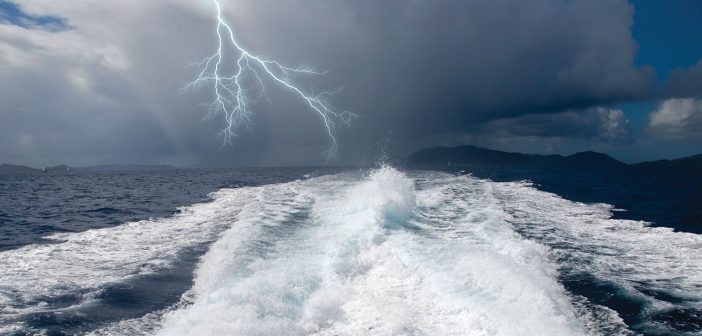Here’s some solid advice from the U.S. Power Squadrons about how to stay safe during lightning strikes on the water:
Lightning strikes kill more people in the United States in a year than tornadoes, and boaters are particularly vulnerable. You can stay safe on and off the water by learning more about lightning safety.
Many people wait far too long to seek shelter when thunderstorms threaten. Unfortunately, this delayed response leads to many lightning deaths and injuries in the U.S.
Lightning dangers for boaters
Often the tallest object in a large open space, a boat can be a dangerous place during a thunderstorm. Seeking the tallest object, lighting blows out the bottom of boats and causes millions of dollars in damage to navigational equipment.
On the water, a direct lightning strike can damage or destroy vessels, overload navigational and other electronic systems, and electrocute crew and passengers.
Let’s consider a few scenarios:
Lightning strikes your boat’s ungrounded radio antenna. The metal antenna carries the electrical charge to the radio, which doesn’t have a good conductor to the water. Your hand is on the radio or on metal connected to the radio, and your feet are on a wet surface, which is in contact with metal that extends through the hull of the boat to the water. As a result, your body may then become the best conductor for the electrical charge.
Lightning strikes your sailboat’s mast. The electrical current follows the mast or wire rope to your hands, through your body to the wet surface, and through the hull to the water.
Lightning strikes you while you’re operating a motorboat. The lightning passes through your body to the motor, then to the water.
Lightning strikes the graphite fishing rod (a good conductor) that you’re holding. You’re sitting in an aluminum or fiberglass rowboat. The electrical charge passes through the rod, your body, and the boat to the water.
In all four examples, you could be seriously injured or killed.
You don’t even need to be touching the components struck by lightning. You could get hit by a side flash, which occurs when the electrical charge jumps from one component to another seeking a better path to ground, namely you.
Lightning strikes have such a high voltage that even non-conductive materials can become conductors. This includes the human body. If these massive voltages start to travel through a boat’s structure—say, through its mast—and meet with high resistance (i.e., the hull skin), the current discharge could blow a hole in the non-conductive barrier to reach ground. Read more:
https://boatingcompass.org/avoid-lightning-strikes-water/




